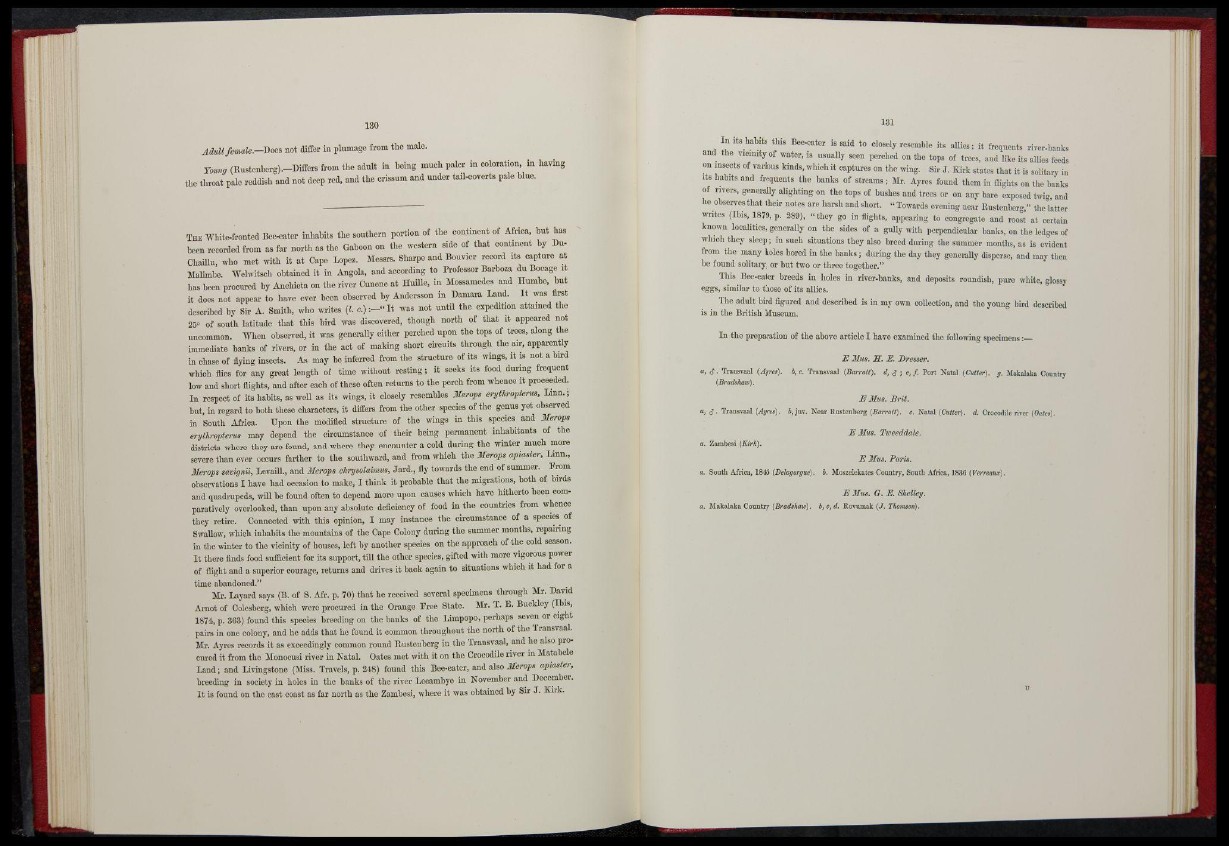
1 30
Adult female.—Does not differ in plumage b om the male.
Ymng (RuStenberg).-Mffcr8 from the adult in being mueh paler in coloration in having
the throat pale reddish and not deep red, and the crissum and under tail-ooverts pale blue.
THE White-fronted Bee-eater inhabits the southern portion of the continent of Africa, but has
been recorded from as far north as the Gaboon on the western side of tliat continent by Du-
Chaillu, who met with it at Cape Lopez. Messrs. Sharpe and Bouvier record its capture at
Malimbe. Welwitsch obtained it in Angola, and according to Professor Barboza du Bocage it
has been procured by Anchieta on the river Cunene at Iluille, in Mossainedes and llumbc, but
it does not appear to have ever been observed by Andersson in Damara Land. It was first
described by Sir A. Smith, who writes (I. c.):—" I t was not until the expedition attained the
25° of south latitude that this bird was discovered, though north of that it appeared not
uncommon. When observed, it was generally either perched upon the tops of trees, along the
immediate banks of rivers, or in the act of making short circuits through the air, apparently
in chase of flying insects. As may be inferred from the structure of its wings, i t is not a bird
which flies for any great length of time without resting; it seeks its food during frequent
low and short flights, and after each of these often returns to t h e perch from whence it proceeded.
I n respect of its habits, as well as its wings, it closely resembles Merops erythropterus, Linn.;
but, in regard to both these characters, it differs from the other species of the genus yet observed
in South Africa. Upon the modified structure of the wings in this species and Merops
erythropterus may depend the circumstance of their being permanent inhabitants of the
districts where they are found, and where they encounter a cold during the winter much more
severe than ever occurs farther to the southward, and from which the Merops ((piaster, Linn.,
Merops sariynii, Lcvaill., and Merops ckrysolaimus, Jard., fly towards the end of summer. From
observations I have had occasion to make, I think it probable that the migrations, both of birds
and quadrupeds, will be found often to depend more upon causes which have hitherto been comparatively
overlooked, than upon any absolute deficiency of food in the countries from whence
they retire. Connected with this opinion, I may instance the circumstance of a species of
SwaUow, which inhabits the mountains of the Cape Colony during the summer months, repairing
in the winter to the vicinity of houses, left by another species on the approach of the cold season.
I t there finds food sufficient for its support, till the other species, gifted with more vigorous power
of flight and a superior courage, returns and drives it back again to situations which it had for a
time abandoned."
Mr. Layard says (B. of S. Afr. p. 70) that he received several specimens through Mr. David
Arnot of Colesberg, which were procured in the Orange Free State. Mr. T. E. Buckley (Ibis,
1871, p. 303) found this species breeding on the banks of the Limpopo, perhaps seven or eight
pairs in one colony, and lie adds that he found it common throughout the north of the Transvaal.
Mr. Ayrcs records i t as exceedingly common round Bustenherg in the Transvaal, and he also procured
it from the Monocusi river in Natal. Oates met with it on the Crocodile river in Matabele
Land; and Livingstone (Miss. Travels, p. 218) found this Bee-eater, and also 3ferops apiaster,
breeding in society in holes in the banks of the river Leeambyc in November and December.
It is found on the east coast as far north as the Zambesi, where it was obtained by Sir J . Kirk.
131
I n its habits this Bee-cater is said to closely resemble its allies; it frequents river-banks
and the vicinity of water, is usually seen perched on the tops of trees, and like its allies feeds
on insects of various kinds, which it captures on the wing. Sir J. Kirk states that it is solitary in
its habits and frequents the banks of streams ; Mr, Ayres found them in flights on the hanks
of rivers, generally alighting on the tops of bushes and trees or on any bare exposed twig, and
be observes that their notes are harsh and short. " Towards evening near Bustenherg," the latter
writes (Ibis, 1879, p. 289), "they go in flights, appearing to congregate and roost at certain
known localities, generally on the sides of a gully with perpendicular banks, on the ledges of
which they sleep; in such situations they also breed during the summer months, as is evident
from the many holes bored in the banks ; during the day they generally disperse, and may then
be found solitary, or but two or three together."
This Bee-eater breeds in holes in river-banks, and deposits roundish, pure white, glossy
eggs, similar to those of its allies.
The adult bird figured and described is in my own collection, and the young bird described
is in the British Museum.
In the preparation of the above article I have examined the following specimens:—
E Mus. H. E. Dresser.
a, J . Transvaal (Ayres). b.c. Transvaal {Barratt). d, <J ; e, ƒ. Port Natal (Cutter), g. Makalaka Country
(Bradshaw).
E Mas. Brit.
a, J . Transvaal (Ayre$). i,jnv. Near Hustcnberg (Barratt). c. Natal (Cutter), d. Crocodile river (Oates).
E Mas. Tireeddale.
a. Zambesi (Kirk).
E Mas. Paris.
a. South Africa, 1845 (Delagorgue). b. Moszelckates Country, South Africa, 183G (Verreaux).
E Mas. O. E. Shelley,
a. Makalaka Country (Bradshaw). b, c, d. Rovumak (J. Thomson).